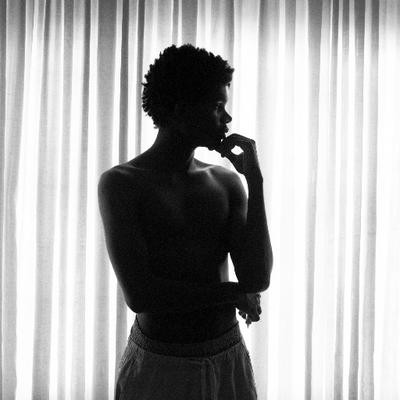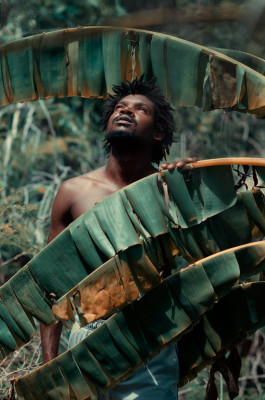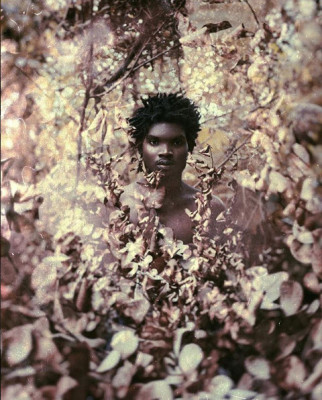Nurture by Delton Barrett
06/28/2018-07/27/2018
Delton Barrett's Imagined Landscape: Photographer Finds New Self in Solitude
Letitia Pratt Interviews Delton Barrett
The D’Aguilar Art Foundation’s new exhibition, “Nurture,” is the product of the most recent experiment of Delton Barrett, an emerging photographer. Hailing from the south of New Providence, Barrett’s preoccupation with creating digitally enhanced, innovative photographic stories has become the catalyst for the experimentation in his work. He often stages scenes within the environment in surreal, fantastic ways, intending to investigate the way his body blends with the space he inhabits. The images that grow out of these explorations are playful renditions of the environment that surrounds him, ultimately communicating a deep connection between his body and the natural world.
Barrett’s ultimate goal is to reflect himself within the landscape that surrounds him; to mirror his masculinity within the foliage that he blends his body into. He asserts his oneness with the roots of trees that stretch far underground. His intentional placement within the unspoilt landscape communicates a need to be seen something deeply, intrinsically apart of the land in a way that brings to the forefront the question of his own freedom – his body, like the land once colonised, now a prop for rebellion against the colonial gaze.
This past Monday, Barrett visited the Foundation to talk about how he manages to capture this magic of freedom in a photograph. We sat among his photos and thought about them for a while.
Letitia Pratt: I want you to tell me of the process of creating these photos, first of all.
Delton Barrett: Okay. The process starts with an idea. And from there is looking for location. After I find the location it’s about setting up how it should look and all that.
LM: So, how do you find the location? How do you decide …
DB: …which is the right one?
LM: Yes.
DB: Based on the concept. If, for example, I have a nature theme I would look for a place with a lot of foliage, and place myself within the negative space within the area. That way I could stand out more within the photo and blend in at the same time.
LM: So you’re placing your body in this negative space – it’s usually your face I see within your work – this emphasis on your face and your gaze. Why do you think it’s important to place yourself in your photographs? What are you confronting when you are looking into the camera that way?
DB: It would defeat the purpose if I don’t [show my face] because I am making self-portraits. And as the subject I want you to see what type of mood I am in. The feeling…the expression… all of that.
LM: So the foliage is indicative of your mood most of the time?
DB: Basically, yes. It’s me adapting to the surroundings. It’s calm. Green is so calm. You can’t be around green and not be calm. I want to capture that calmness.
LM: You told me when we were setting up this exhibition, that it was your intention to become one with green. Why is that important to you? I guess, like you just said that it reflects your mood.
DB: Exactly…expression, it builds the mood, and basically puts more emphasis on the idea. Whatever the idea may be.
LM: So landscape for you means something considerably different for you than, let’s say, the usual tourism photos of serene beaches and scenes of downtown Nassau, right?
DB: Yes. I like the solitude. You don’t have a lot of people around, distracting you from doing…or creating what you’re trying to do. I find it’s best that I take pictures when no one is around because it actually helps make a better photo. A lot of people comment that they hve never seen places like this before, and that’s the kind of reaction that I want. I don’t want the picture to be something you see every day, like downtown. Well, unless I do want it to. Certain ideas require different spaces.
LM: But most of them you need solitude.
DB: Yeah.
LM: What are these ideas?
DB: Okay, for example, Failed Attempts to Fly, is a photo of me ‘attempting’ to fly on the beach. I needed to be on the shore alone in order to keep the focus on me as the subject. That way the picture would be stronger. But if I wanted to go to a populated area for a photo…like ….
LM: Goodman’s Bay.
DB: Like Goodman’s Bay, it would be different. If I wanted that reaction, I would do that, I would engage with people, crowded areas and the public. But for most of the work in this exhibition, it isn't necessary.
LM: So you don’t want the reaction from anybody when you’re in the solitude of nature.
DB: I want the reaction, but not in the present. I want the reaction after I take the photo.
LM: When I think of land, especially regarding the connection you have created between it and your body within your work, I think about ownership, and this history of colonisation of both land and the Black body. How do you think your process reclaims both of these things? Because I do find your photos as a sort of reclamation in a way.
DB: That’s actually one of the reasons why I like going in nature. It actually feels free. You know. Living in the south, where I do my photoshoots, a lot of people aren’t on that particular beach. It’s basically just the sea, breeze, and there might be some birds, dogs, or one or two people running on the shore but it’s just nature, nature, nature. And I think that’s where most of my ideas come from; being in solitude. In the natural space you get to see a lot of things in nature that transform into ideas, along with random props like bottles, cans, buckets and tires, you know how people dump their trash.
LM: Yes, you use them a lot in your photos, especially in Media Intoxication.
DB: And most of them are on the spot and untouched photos; I really don’t have to stage anything. And then, viewers comment “how you get that on the beach”? Well, it was always on the beach, I just highlighted and played with it. It’s just now a part of my scene. I feel like everywhere I shoot I have ownership of the place because it’s now my setting and I can do whatever I want to it and have control over the environment. I have the freedom to.



